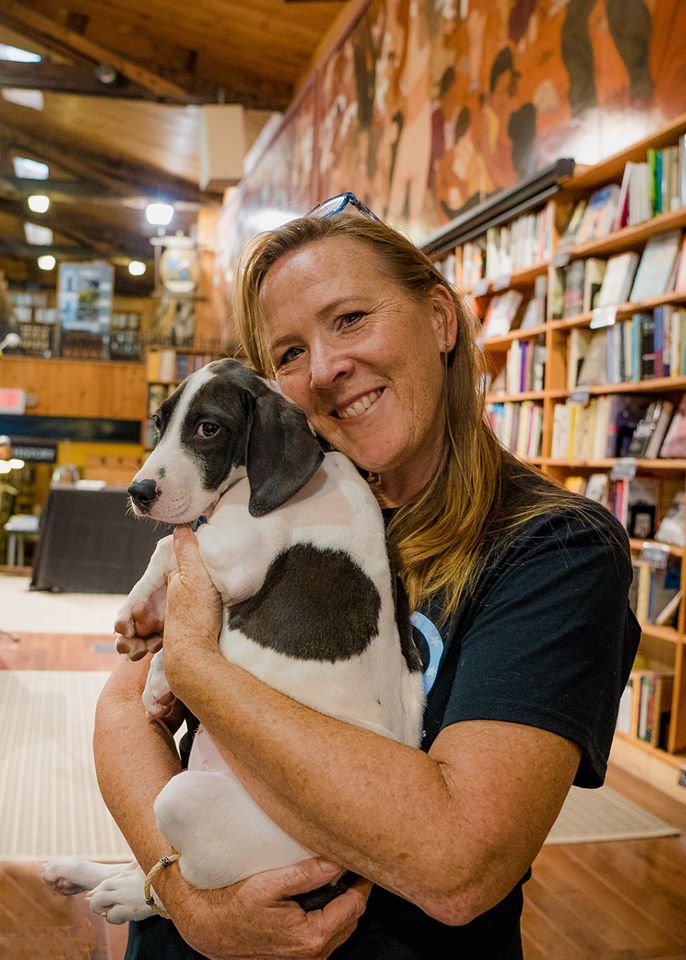I always learn something at every shelter we visit, but at Moore County Animal Services, we saw an entirely different way of doing adoptions.
The entire staff has completed the Fear Free shelter program. To minimize the stress on their dogs, they do not allow the public to tour the kennels to pick a dog. Having people walking back and forth through the kennels is extremely stressful for the already stressed dogs.
Instead, they have a kiosk in the lobby, where potential adopters can click through the pictures and information of the dogs in the kennels. The staff talks with them about what they are looking for and what kind of home they can offer, and then counsels the adopter on which dogs might be the best match. After that, they bring the dogs up front to meet the adopter in a meet and greet room.
It’s a smart way to give every dog a chance. Many dogs don’t show well in their kennels. Some develop barrier aggression, protecting the only space that is ‘theirs’, they may lunge or bark. When you bring them out they are completely different dogs, but few will request to meet the dog snarling and lunging at them.
Other dogs are terrified by the noise created when an entire room full of dogs excited by a person walking through. They may cower in the back of their crate, terrified. That same dog out in the play yard might be friendly and energetic.


The staff knows the animals best and once they understand what an adopter is looking for, they make the best matchmakers. I love this approach and wish more shelters would employ it. If they don’t have the funds for an interactive kiosk as cool as Moore Counties, they could just as easily set something up on a computer, or even print the information out in books.
Moore County Animal Services is a large shelter run by the Sheriff’s department. They are an open intake shelter that handles about three thousand animals a year with a staff of just seven full time employees, 1 part time kennel tech (newly hired), and 4 ACO’s.





We met with their director, James (who also oversees two other departments), Marissa, the shelter manager and vet tech, Octavius, who is the administrative assistant, rescue coordinator, and handles all the finances, plus Adam, James’ replacement (James is retiring soon). They seem like a team that works well together and takes pride in the work they do.




It was refreshing to hear that the shelter not only adopts out all their animals already spayed or neutered, they finance a Fix ‘Em program to offer low-cost spay/neuter for the public. Octavius networks dogs to their 66 rescue partners, but an equal or larger number are adopted out locally.
They have a Mobile Adoption Center, funded by donations and a grant from Pet Smart. It’s an amazing trailer tricked out with kennels and heat/AC that is perfect for getting their animals out into the public eye, but they’ve also used it to assist citizens in times of crisis, providing a safe place for their animals temporarily in the event of floods and other disasters.




The shelter reports for North Carolina are public record. In 2022 Moore County handled 1165 dogs and euthanized 27% (320) of them.
Moore County ACOs handle a huge number of calls. They work to not just assist citizens, but educate them. Prior to the pandemic, they had a program in place called Dog Tags, that utilized soldiers from nearby Fort Bragg to train shelter dogs. The team is hopeful that program will return.
The challenge of having a shelter that falls under the Sheriff’s department is that heriff is an elected position, so the shelter staff and practices can change with each election. That makes it hard to create consistency and stability with the staff and the community.
As we travel from shelter to shelter, it is interesting to see all the different models and hear about the different approaches to sheltering. What I wish, though, is that there could be some kind of consistency. I wish a dog’s fate wasn’t determined by county lines. I wish every dog had the same chance. I wish we could all decide that euthanizing a dog should be an absolute last resort only for medically or behaviorally irredeemable dogs. I wish we could agree to take that option off the table for savable dogs, because the one thing I’ve learned from visiting over one hundred shelters is that there are thousands of better options, available to all of us regardless of where we live. We just have to decide to look for them.

Until each one has a home,
Cara
If you want to learn more, be sure to subscribe to this blog. And help us spread the word by sharing this post with others. Visit our website to learn more.
You can also help raise awareness by following/commenting/sharing us on Facebook, Instagram, YouTube, Tik Tok, and the Who Will Let the Dogs Out podcast.

Learn more about what is happening in our southern shelters and rescues in the book, One Hundred Dogs & Counting: One Woman, Ten Thousand Miles, and a Journey Into the Heart of Shelters and Rescues (Pegasus Books, 2020). It’s the story of a challenging foster dog who inspired me to travel south to find out where all the dogs were coming from. It tells the story of how Who Will Let the Dogs Out began. Find it anywhere books are sold. A portion of the proceeds of every book sold go to help unwanted animals in the south.
For more information on any of our projects, to talk about rescue in your neck of the woods, or become a WWLDO volunteer, please email whowillletthedogsout@gmail.com or carasueachterberg@gmail.com.
And for links to everything WWLDO check out our Linktree.



Leave a Comment
Sign up for our newsletter
Sign up to have our latest news, grant updates, shelter visits, and more delivered to your inbox.
Share this:
Like this: